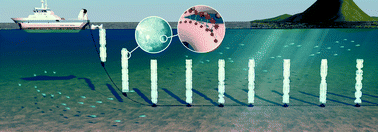当前位置:
X-MOL 学术
›
Sustain. Energy Fuels
›
论文详情
Our official English website, www.x-mol.net, welcomes your feedback! (Note: you will need to create a separate account there.)
The use of silver nanoparticles for the recovery of uranium from seawater by means of biofouling mitigation
Sustainable Energy & Fuels ( IF 5.6 ) Pub Date : 2018-08-17 , DOI: 10.1039/c8se00228b Margaret Flicker Byers 1, 2, 3, 4, 5 , Sheldon Landsberger 1, 2, 3, 4, 5 , Erich Schneider 1, 2, 3, 4, 5
Sustainable Energy & Fuels ( IF 5.6 ) Pub Date : 2018-08-17 , DOI: 10.1039/c8se00228b Margaret Flicker Byers 1, 2, 3, 4, 5 , Sheldon Landsberger 1, 2, 3, 4, 5 , Erich Schneider 1, 2, 3, 4, 5
Affiliation

|
Research currently being carried out by a consortium of national laboratory and university partners is leading to the development of advanced adsorbent materials suitable for the industrial-scale recovery of the essentially limitless supply of uranium naturally contained within the worlds oceans. Experiments have shown however that marine biofouling has decreased the uranium capacity of these adsorbent fibers by approximately 30%. Given the commensurate impact adsorbent capacity has on the projected cost of seawater uranium, this work seeks to mitigate the effects of marine biofouling in order to restore capacity to that of the unfouled fibers. A review of antifouling strategies showed that just one, incorporation of silver nanoparticles into the adsorbent matrix, was likely to meet cost and practicality goals. The ability of silver doped adsorbents to restore capacity to that of the unfouled adsorbents is quantified by means of a capacity restoration factor, seen to increase with silver content in the adsorbent. These results showed that the silver nanoparticles are extremely effective at eliminating the ca. 20% share of capacity loss that is directly attributed to the biological organisms. This work also identified the a-biotic conditioning film as a primary driver of loss in uptake due to biofouling, which provides finer resolved data and a deeper understanding of uranium uptake experiments, conducted externally, that showed a constant reduction in uptake at all measured data points, the smallest of which was 7 days. Data reduction showed that under the most extreme fouling conditions, approximately 80% of the uptake loss was ascribable to the fast-developing film, against which silver is observed to have little effect. Therefore this work was significant in proving that seawater uranium recovery efforts need to refocus on halting the formation of this abiotic film to improve uranium capacity.
中文翻译:

利用银纳米颗粒通过减轻生物污染来从海水中回收铀
由国家实验室和大学合作伙伴组成的联盟目前正在进行的研究正在开发适合工业规模回收世界上自然包含的无限量铀的工业规模吸收的先进吸附剂材料。然而,实验表明,海洋生物污染已使这些吸附纤维的铀容量降低了约30%。考虑到吸附剂容量对海水铀预计成本的影响是相称的,这项工作旨在减轻海洋生物污染的影响,以恢复未污染纤维的容量。一项关于防污策略的综述表明,只有一种将银纳米颗粒掺入吸附剂基质中,才能满足成本和实用性目标。掺杂银的吸附剂将容量恢复为未污染吸附剂的容量的能力通过容量恢复因子来定量,该容量恢复因子被视为随吸附剂中银含量的增加而增加。这些结果表明,银纳米颗粒在消除金属粉尘方面非常有效。约。直接归因于生物体的容量损失占20%。这项工作还确定了非生物调节膜是生物结垢引起的吸收损失的主要驱动力,这提供了更精细的解析数据以及对外部进行的铀吸收实验的更深入的了解,这些实验表明,在所有测量数据中,吸收的持续减少点,最小的是7天。数据减少表明,在最极端的结垢条件下,约80%的吸收损失可归因于快速显影的薄膜,而观察到的银几乎没有影响。因此,这项工作对于证明海水铀回收工作需要重新集中于制止这种非生物膜的形成以提高铀容量方面具有重要意义。
更新日期:2018-09-25
中文翻译:

利用银纳米颗粒通过减轻生物污染来从海水中回收铀
由国家实验室和大学合作伙伴组成的联盟目前正在进行的研究正在开发适合工业规模回收世界上自然包含的无限量铀的工业规模吸收的先进吸附剂材料。然而,实验表明,海洋生物污染已使这些吸附纤维的铀容量降低了约30%。考虑到吸附剂容量对海水铀预计成本的影响是相称的,这项工作旨在减轻海洋生物污染的影响,以恢复未污染纤维的容量。一项关于防污策略的综述表明,只有一种将银纳米颗粒掺入吸附剂基质中,才能满足成本和实用性目标。掺杂银的吸附剂将容量恢复为未污染吸附剂的容量的能力通过容量恢复因子来定量,该容量恢复因子被视为随吸附剂中银含量的增加而增加。这些结果表明,银纳米颗粒在消除金属粉尘方面非常有效。约。直接归因于生物体的容量损失占20%。这项工作还确定了非生物调节膜是生物结垢引起的吸收损失的主要驱动力,这提供了更精细的解析数据以及对外部进行的铀吸收实验的更深入的了解,这些实验表明,在所有测量数据中,吸收的持续减少点,最小的是7天。数据减少表明,在最极端的结垢条件下,约80%的吸收损失可归因于快速显影的薄膜,而观察到的银几乎没有影响。因此,这项工作对于证明海水铀回收工作需要重新集中于制止这种非生物膜的形成以提高铀容量方面具有重要意义。


























 京公网安备 11010802027423号
京公网安备 11010802027423号